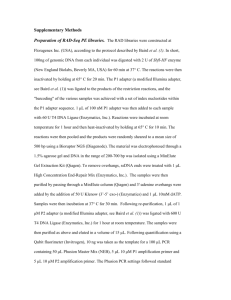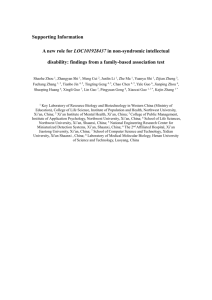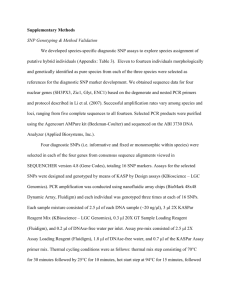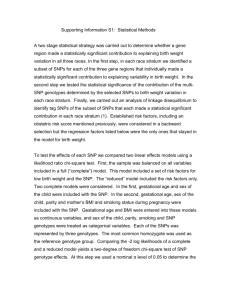Additional file 1
advertisement
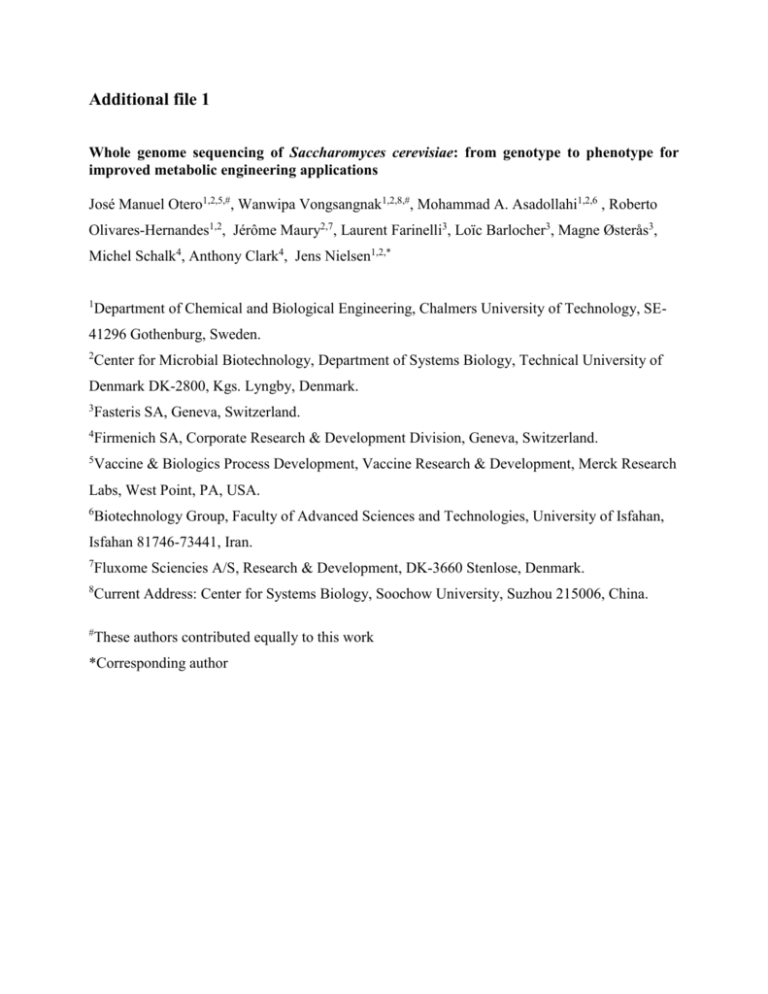
Additional file 1 Whole genome sequencing of Saccharomyces cerevisiae: from genotype to phenotype for improved metabolic engineering applications José Manuel Otero1,2,5,#, Wanwipa Vongsangnak1,2,8,#, Mohammad A. Asadollahi1,2,6 , Roberto Olivares-Hernandes1,2, Jérôme Maury2,7, Laurent Farinelli3, Loïc Barlocher3, Magne Østerås3, Michel Schalk4, Anthony Clark4, Jens Nielsen1,2,* 1 Department of Chemical and Biological Engineering, Chalmers University of Technology, SE- 41296 Gothenburg, Sweden. 2 Center for Microbial Biotechnology, Department of Systems Biology, Technical University of Denmark DK-2800, Kgs. Lyngby, Denmark. 3 Fasteris SA, Geneva, Switzerland. 4 Firmenich SA, Corporate Research & Development Division, Geneva, Switzerland. 5 Vaccine & Biologics Process Development, Vaccine Research & Development, Merck Research Labs, West Point, PA, USA. 6 Biotechnology Group, Faculty of Advanced Sciences and Technologies, University of Isfahan, Isfahan 81746-73441, Iran. 7 Fluxome Sciencies A/S, Research & Development, DK-3660 Stenlose, Denmark. 8 Current Address: Center for Systems Biology, Soochow University, Suzhou 215006, China. # These authors contributed equally to this work *Corresponding author Content 1. 2. 3. 4. 5. 6. Figure S1: Gene Ontology terms for SNP characterization. Figure S2: SNP enrichment in S. cerevisiae metabolism. Figure S3: Methodology for SNP characterization at amino acid level. Figure S4: Conservation distance. Figure S5: SNP analysis of ERG8 at nucleotide positions 49 and 247. Figure S6: Amino acid characterization of SNPs detected between S288c and CEN.PK113-7D. 7. Figure S7: Gene ontology terms for S288c v. CEN.PK113-7D (Glucose). 8. Figure S8: Gene ontology terms for S288c vs. CEN.PK113-7D (Galactose). 9. Figure S9: Metabolic pathway expression mapping for S288c Glucose vs. CEN.PK1137D Glucose. 10. Figure S10: Metabolic pathway expression mapping for S288c Galactose vs. CEN.PK113-7D Galactose. 11. Table S1: Transcriptome – S288c v CEN.PK113-7D Glucose. 12. Table S2: Transcriptome – S288c v CEN.PK113-7D Galactose. 13. Table S3: Description of S. cerevisiae strains 14. Table S4: EDENA determination for de novo assembly of S288c and CEN.PK113-7D sequences. GO Function, Nonsynonymous SNP characterization FUNCTION,Non-silent Non-silentSNP SNPCharacterization Characterization GOGO FUNCTION, serine-type peptidase activity serine-type peptidase activity O-acyltransferase activity O-acyltransferase activity transferase activity, transferring alkyl or aryl (other than methyl) … transferase activity, transferring alkyl or aryl (other than methyl) … lyase activity lyase activity glucosyltransferase activity glucosyltransferase activity carbon-carbon lyase activity carbon-carbon lyase activity UDP-glucosyltransferase activity UDP-glucosyltransferase activity mannosyltransferase activity mannosyltransferase activity oxidoreductase activity oxidoreductase activity UDP-glycosyltransferase activity UDP-glycosyltransferase activity transferase activity, transferring glycosyl groups transferase activity, transferring glycosyl groups transferase activity, transferring hexosyl groups transferase activity, transferringtransferase hexosyl groups activity transferase activity catalytic activity catalytic activity P-value P-value No. Genes No. Genes COMPONENT Non-silentSNP SNP Characterization GO Component,GONonsynonymous characterization GO COMPONENT Non-silent SNP Characterization intracellular part intracellular part cytoplasmic part cytoplasmic part intracellular intracellular cell cell cell part cell part cytoplasm cytoplasm P-value P-value No. Genes No. Genes Figure S1. Gene Ontology (GO) function and component terms for the nonsynonymous SNPs identified in CEN.PK113-7D compared to S288c. The x-axis in log-scale displays both the significance of each category (p < 0.01, symbol: solid black), and the number of genes from the total of 85 containing nonsynonymous SNPs (symbol: solid white). GO process characterization performed using the Saccharomyces Genome Database (SGD). SNP Mapping: Red indicates nonsilent SNP and blue indicates silent SNPs SNP Mapping: Red indicates Nonsynonymous SNPs and No. ofblue Metabolically indicates silent SNPs Identified SNPs 158 (silent and non-silent) No. of Metabolically Identified SNPs 158 No.and of Nonsynonymous) Metabolically (Silent 85 Identified Non-silent SNPs No. of Metabolically Identified 85 Nonsynonymous SNPs Figure S2. SNP enrichment in S. cerevisiae metabolism. The metabolic map, produced using the Saccharomyces Genome Database (SGD) Expression Viewer (SRI International Pathway Tools version 12.0, based upon S. cerevisiae S288c, version 12.0) was created using the SNP data produced for CEN.PK113-7D compared to S288c. Pathways in red indicate nonsynonymous SNPs (85 genes) while those in blue indicate silent SNPs (73 genes). Note that number of genes does not necessarily coincide with number of pathways due to iso-enzymes. S288C v CEN.PK113-7D protein with SNP(s) compared to top 10 homologous protein sequences based on Pfam search and multiple alignment. Each amino acid at the position of the SNP identified, catalogued, and characterized. Calculations of frequency of occurrence performed. S288C Frequency No. of Proteins with S288C AA Total No. of Homologous Proteins (Pfam) CEN.PK Frequency No. of Proteins with SNP AA Total No. of Homologous Proteins (Pfam) Conservati on Distance S288C Frequency - CEN.PK Frequency Amino acids characterized according to major classification categories1 Aliphatic Aromatic Polar Non-polar Charged Positive Tiny Small Acidic Sulfur Hydrophobic Hydrophilic Basic Total of 210 SNPs across 85 metabolic genes characterized 1. Lehninger Principles of Biochemistry, 4th edition (David L. Nelson, Michael M. Cox, eds.) Figure S3. The above flow-diagram describes the bioinformatics approach taken to estimate the likelihood of occurrence of a nonsynonymous SNP in CEN.PK113-7D or S288c. Specifically, the top 10 homologous protein sequences based on Pfam search and multiple alignments were determined. Each amino acid the SNP position identified was catalogued and characterized. Specifically, indices referred to as the S288c Frequency, CEN.PK Frequency, and Conservation Distance was calculated. The Conservation Distance, bound from -1 to 1, is a convenient measure of whether the nucleotide detected in CEN.PK113-7D or S288c is dominant compared to homologous sequences. Resulting amino acids were then characterized according to their physical chemistry properties. Conservation Distance Average ± SD = 0.03 ± 0.40 Figure S4. The Conservation Distance, previously described in Additional file 1, Figure S3, is plotted for all 210 nonsynonymous SNPs. 0.25 YMR220W ERG8 49 YMR220W ERG8 247 0.25 0.75 0.67 0.67 S288C Match Frequency Conservation Dist. 0.00 0.00 CEN.PK Match Frequency Dominant AA Frequency -0.25 Conservation Dist. S288C Match Frequency CEN.PK Match Frequency Frequency Across Pfam Alignment 0.75 Frequency Across Pfam Alignment 0.75 0.75 0.5 0 0.75 0.75 0.5 0.25 0.25 0 Dominant AA Frequency 0.25 0 0 0 S288C v CEN.PK AA Characterization YMR220W ERG8 49 S288C CEN.PK 0 0 0 0 0 0 0 0 0 S288C v CEN.PK AA Characterization YMR220W ERG8 247 S288C CEN.PK Figure S5. The gene ERG8 of the ergosterol synthesis pathway contains a total of 4 nonsynonymous SNPs, two of which, located at nucleotide positions 49 and 247, are analyzed here. The top plots show the CEN.PK Match Frequency, Dominant AA Frequency, S288c Match Frequency, and Conversation Distance. The middle plots show the frequency (fraction) of each categorization across the amino acid sequences resulting from Pfam multi-sequence alignment. The bottom plots show the characterization of the original S288c amino acid (symbol: blue bar) and the CEN.PK113-7D amino acid (symbol: red bar). 0 0 Figure S6. Brief Description of Amino Acid Characterization – CEN.PK113-7D vs S288c Profiles In the figure that follows, the same amino acid characterization as presented earlier was performed for only the CEN.PK113-7D sequence (referred to as “SNP”), and the S288c sequence (referred to as “SGD”). The scoring system was a simple binary assignment, where 0 indicated the amino acid did not fall into the category or 1 indicating that it did. Therefore, the plots that follow should have the following interpretation: If the value of the individual amino acid is zero, than neither the SNP (CEN.PK1137D) or SGD (S288c) amino acid qualify for that category If the value of the individual amino acid is 1, then only one of the sequences – SNP (CEN.PK113-7D) or SGD (S288c) – fall into the category, suggesting a change in characterization. The color codes should then be used to determine which sequence falls into the category. If the value of the individual amino acid is 2, then both sequences fall into that functional category. Note that on the y-axis is the individual nonsynonymous SNPs. The naming nomenclature used is “GeneSNP”, such that for the example “BET2143”, the gene is BET2 and the SNP is at nucleotide position 143. Due to the large number of SNPs each individual name is not included. Therefore, the plots that follow intend to provide a visual perspective for how many nonsynonymous SNPs resulted in a functional amino acid change. Aliphatic Aromatic Polar Non-Polar BET2143 BET2143 BET2143 PIK1382 PIK1382 PIK1382 BET2143 PIK1382 HAF11798 HAF11798 HAF11798 HAF11798 HFA11056 HFA11056 HFA11056 HFA11056 HFA1579 HFA1579 HFA1579 HFA1579 URA21852 URA21852 URA21852 URA21852 URA2123 URA2123 URA2123 URA2123 ARG5,6521 ARG5,6521 ARG5,6521 ARG5,6521 PAD198 PAD198 PAD198 PAD198 RBK1301 RBK1301 RBK1301 RBK1301 ROT2882 ROT2882 ROT2882 ROT2882 ROT2523 ROT2523 ROT2523 ROT2523 ROT294 ROT294 ROT294 ROT294 MET861 MET861 MET861 MET861 MNN2412 MNN2412 MNN2412 MNN2412 MNN2164 MNN2164 MNN2164 MNN2164 NTH2483 NTH2483 NTH2483 NTH2483 SCT1217 SCT1217 SCT1217 SCT1217 ARO11386 ARO11386 ARO11386 ARO11386 ARO1517 ARO1517 ARO1517 ARO1517 GAL10518 GAL10518 GAL10518 GAL10518 GPI16148 GPI16148 GPI16148 GPI16148 MNN5292 MNN5292 MNN5292 MNN5292 ADE16284 ADE16284 ADE16284 ADE16284 FAA2580 FAA2580 FAA2580 FAA2580 QRI1189 QRI1189 QRI1189 QRI1189 PHO11 0 PHO11 0 PHO11 0 PHO11 0 RPM2942 RPM2942 RPM2942 RPM2942 RPM2642 RPM2642 RPM2642 RPM2642 RPM2469 RPM2469 RPM2469 RPM2469 RPM2291 RPM2291 RPM2291 RPM2291 URA4319 URA4319 URA4319 URA4319 COX1223 COX1223 COX1223 COX1223 FAB11552 FAB11552 FAB11552 FAB11552 FAB1812 FAB1812 FAB1812 FAB1812 GAL1414 GAL1414 GAL1414 GAL1414 ADH4393 ADH4393 ADH4393 ADH4393 ERG9286 ERG9286 ERG9286 ERG9286 YHL012W334 YHL012W334 YHL012W334 YHL012W334 YHL012W274 YHL012W274 YHL012W274 YHL012W274 PMT1361 PMT1361 PMT1361 PMT1361 HIS2249 HIS2249 HIS2249 HIS2249 ERG8247 ERG8247 ERG8247 ERG8247 ERG849 ERG849 ERG849 ERG849 BIO3295 BIO3295 BIO3295 BIO3295 APA269 APA269 APA269 APA269 PLC1730 PLC1730 PLC1730 PLC1730 PLC1528 PLC1528 PLC1528 PLC1528 PLC1181 PLC1181 PLC1181 PLC1181 MET2240 MET2240 MET2240 MET2240 GPI10151 GPI10151 GPI10151 GPI10151 POX1540 POX1540 POX1540 POX1540 POX1103 POX1103 POX1103 POX1103 KEX1338 KEX1338 KEX1338 KEX1338 GAD1434 GAD1434 GAD1434 GAD1434 FAA4321 FAA4321 FAA4321 FAA4321 PAN6109 PAN6109 PAN6109 PAN6109 PMT5269 PMT5269 PMT5269 PMT5269 PRD1668 PRD1668 PRD1668 PRD1668 PRD1234 PRD1234 PRD1234 PRD1234 TRP2389 TRP2389 TRP2389 TRP2389 PCM1196 PCM1196 PCM1196 PCM1196 KEX2633 KEX2633 KEX2633 KEX2633 KEX2615 KEX2615 KEX2615 KEX2615 DUR1,21476 DUR1,21476 DUR1,21476 DUR1,21476 DUR1,2459 DUR1,2459 DUR1,2459 DUR1,2459 TSL1415 TSL1415 TSL1415 TSL1415 LPD183 LPD183 LPD183 LPD183 MCT190 MCT190 MCT190 MCT190 PDC6270 PDC6270 PDC6270 PDC6270 0.00 SNP 1.00 SGD 2.00 0.00 SNP 1.00 SGD 2.00 0.00 SNP 1.00 SGD 2.00 0.00 SNP 1.00 SGD 2.00 Charged Positive Tiny Small BET2143 BET2143 BET2143 PIK1382 PIK1382 PIK1382 BET2143 PIK1382 HAF11798 HAF11798 HAF11798 HAF11798 HFA11056 HFA11056 HFA11056 HFA11056 HFA1579 HFA1579 HFA1579 HFA1579 URA21852 URA21852 URA21852 URA21852 URA2123 URA2123 URA2123 URA2123 ARG5,6521 ARG5,6521 ARG5,6521 ARG5,6521 PAD198 PAD198 PAD198 PAD198 RBK1301 RBK1301 RBK1301 RBK1301 ROT2882 ROT2882 ROT2882 ROT2882 ROT2523 ROT2523 ROT2523 ROT2523 ROT294 ROT294 ROT294 ROT294 MET861 MET861 MET861 MET861 MNN2412 MNN2412 MNN2412 MNN2412 MNN2164 MNN2164 MNN2164 MNN2164 NTH2483 NTH2483 NTH2483 NTH2483 SCT1217 SCT1217 SCT1217 SCT1217 ARO11386 ARO11386 ARO11386 ARO11386 ARO1517 ARO1517 ARO1517 ARO1517 GAL10518 GAL10518 GAL10518 GAL10518 GPI16148 GPI16148 GPI16148 GPI16148 MNN5292 MNN5292 MNN5292 MNN5292 ADE16284 ADE16284 ADE16284 ADE16284 FAA2580 FAA2580 FAA2580 FAA2580 QRI1189 QRI1189 QRI1189 QRI1189 PHO11 0 PHO11 0 PHO11 0 PHO11 0 RPM2942 RPM2942 RPM2942 RPM2942 RPM2642 RPM2642 RPM2642 RPM2642 RPM2469 RPM2469 RPM2469 RPM2469 RPM2291 RPM2291 RPM2291 RPM2291 URA4319 URA4319 URA4319 URA4319 COX1223 COX1223 COX1223 COX1223 FAB11552 FAB11552 FAB11552 FAB11552 FAB1812 FAB1812 FAB1812 FAB1812 GAL1414 GAL1414 GAL1414 GAL1414 ADH4393 ADH4393 ADH4393 ADH4393 ERG9286 ERG9286 ERG9286 ERG9286 YHL012W334 YHL012W334 YHL012W334 YHL012W334 YHL012W274 YHL012W274 YHL012W274 YHL012W274 PMT1361 PMT1361 PMT1361 PMT1361 HIS2249 HIS2249 HIS2249 HIS2249 ERG8247 ERG8247 ERG8247 ERG8247 ERG849 ERG849 ERG849 ERG849 BIO3295 BIO3295 BIO3295 BIO3295 APA269 APA269 APA269 APA269 PLC1730 PLC1730 PLC1730 PLC1730 PLC1528 PLC1528 PLC1528 PLC1528 PLC1181 PLC1181 PLC1181 PLC1181 MET2240 MET2240 MET2240 MET2240 GPI10151 GPI10151 GPI10151 GPI10151 POX1540 POX1540 POX1540 POX1540 POX1103 POX1103 POX1103 POX1103 KEX1338 KEX1338 KEX1338 KEX1338 GAD1434 GAD1434 GAD1434 GAD1434 FAA4321 FAA4321 FAA4321 FAA4321 PAN6109 PAN6109 PAN6109 PAN6109 PMT5269 PMT5269 PMT5269 PMT5269 PRD1668 PRD1668 PRD1668 PRD1668 PRD1234 PRD1234 PRD1234 PRD1234 TRP2389 TRP2389 TRP2389 TRP2389 PCM1196 PCM1196 PCM1196 PCM1196 KEX2633 KEX2633 KEX2633 KEX2633 KEX2615 KEX2615 KEX2615 KEX2615 DUR1,21476 DUR1,21476 DUR1,21476 DUR1,21476 DUR1,2459 DUR1,2459 DUR1,2459 DUR1,2459 TSL1415 TSL1415 TSL1415 TSL1415 LPD183 LPD183 LPD183 LPD183 MCT190 MCT190 MCT190 MCT190 PDC6270 PDC6270 0.00 SNP 1.00 SGD 2.00 PDC6270 0.00 SNP 1.00 SGD 2.00 PDC6270 0.00 SNP 1.00 SGD 2.00 0.00 SNP 1.00 SGD 2.00 Acidic Basic Hydrophobic BET2143 BET2143 PIK1382 PIK1382 BET2143 PIK1382 HAF11798 HAF11798 HAF11798 HFA11056 HFA11056 HFA11056 HFA1579 HFA1579 HFA1579 URA21852 URA21852 URA21852 URA2123 URA2123 URA2123 ARG5,6521 ARG5,6521 ARG5,6521 PAD198 PAD198 PAD198 RBK1301 RBK1301 RBK1301 ROT2882 ROT2882 ROT2882 ROT2523 ROT2523 ROT2523 ROT294 ROT294 ROT294 MET861 MET861 MET861 MNN2412 MNN2412 MNN2412 MNN2164 MNN2164 MNN2164 NTH2483 NTH2483 NTH2483 SCT1217 SCT1217 SCT1217 ARO11386 ARO11386 ARO11386 ARO1517 ARO1517 ARO1517 GAL10518 GAL10518 GAL10518 GPI16148 GPI16148 GPI16148 MNN5292 MNN5292 MNN5292 ADE16284 ADE16284 ADE16284 FAA2580 FAA2580 FAA2580 QRI1189 QRI1189 QRI1189 PHO11 0 PHO11 0 PHO11 0 RPM2942 RPM2942 RPM2942 RPM2642 RPM2642 RPM2642 RPM2469 RPM2469 RPM2469 RPM2291 RPM2291 RPM2291 URA4319 URA4319 URA4319 COX1223 COX1223 COX1223 FAB11552 FAB11552 FAB11552 FAB1812 FAB1812 FAB1812 GAL1414 GAL1414 GAL1414 ADH4393 ADH4393 ADH4393 ERG9286 ERG9286 ERG9286 YHL012W334 YHL012W334 YHL012W334 YHL012W274 YHL012W274 YHL012W274 PMT1361 PMT1361 PMT1361 HIS2249 HIS2249 HIS2249 ERG8247 ERG8247 ERG8247 ERG849 ERG849 ERG849 BIO3295 BIO3295 BIO3295 APA269 APA269 APA269 PLC1730 PLC1730 PLC1730 PLC1528 PLC1528 PLC1528 PLC1181 PLC1181 PLC1181 MET2240 MET2240 MET2240 GPI10151 GPI10151 GPI10151 POX1540 POX1540 POX1540 POX1103 POX1103 POX1103 KEX1338 KEX1338 KEX1338 GAD1434 GAD1434 GAD1434 FAA4321 FAA4321 FAA4321 PAN6109 PAN6109 PAN6109 PMT5269 PMT5269 PMT5269 PRD1668 PRD1668 PRD1668 PRD1234 PRD1234 PRD1234 TRP2389 TRP2389 TRP2389 PCM1196 PCM1196 PCM1196 KEX2633 KEX2633 KEX2633 KEX2615 KEX2615 KEX2615 DUR1,21476 DUR1,21476 DUR1,21476 DUR1,2459 DUR1,2459 DUR1,2459 TSL1415 TSL1415 TSL1415 LPD183 LPD183 LPD183 MCT190 MCT190 MCT190 PDC6270 PDC6270 0.00 SNP 1.00 SGD 2.00 PDC6270 0.00 SNP 1.00 SGD 2.00 0.00 SNP 1.00 SGD 2.00 Sulfur Containing Hydroxylic BET2143 BET2143 PIK1382 PIK1382 HAF11798 HAF11798 HFA11056 HFA11056 HFA1579 HFA1579 URA21852 URA21852 URA2123 URA2123 ARG5,6521 ARG5,6521 PAD198 PAD198 RBK1301 RBK1301 ROT2882 ROT2882 ROT2523 ROT2523 ROT294 ROT294 MET861 MET861 MNN2412 MNN2412 MNN2164 MNN2164 NTH2483 NTH2483 SCT1217 SCT1217 ARO11386 ARO11386 ARO1517 ARO1517 GAL10518 GAL10518 GPI16148 GPI16148 MNN5292 MNN5292 ADE16284 ADE16284 FAA2580 FAA2580 QRI1189 QRI1189 PHO11 0 PHO11 0 RPM2942 RPM2942 RPM2642 RPM2642 RPM2469 RPM2469 RPM2291 RPM2291 URA4319 URA4319 COX1223 COX1223 FAB11552 FAB11552 FAB1812 FAB1812 GAL1414 GAL1414 ADH4393 ADH4393 ERG9286 ERG9286 YHL012W334 YHL012W334 YHL012W274 YHL012W274 PMT1361 PMT1361 HIS2249 HIS2249 ERG8247 ERG8247 ERG849 ERG849 BIO3295 BIO3295 APA269 APA269 PLC1730 PLC1730 PLC1528 PLC1528 PLC1181 PLC1181 MET2240 MET2240 GPI10151 GPI10151 POX1540 POX1540 POX1103 POX1103 KEX1338 KEX1338 GAD1434 GAD1434 FAA4321 FAA4321 PAN6109 PAN6109 PMT5269 PMT5269 PRD1668 PRD1668 PRD1234 PRD1234 TRP2389 TRP2389 PCM1196 PCM1196 KEX2633 KEX2633 KEX2615 KEX2615 DUR1,21476 DUR1,21476 DUR1,2459 DUR1,2459 TSL1415 TSL1415 LPD183 LPD183 MCT190 MCT190 PDC6270 PDC6270 0.00 SNP 1.00 SGD 2.00 0.00 SNP 1.00 SGD 2.00 GO PROCESS, LFC>0, S288C v CENPK [Glucose] GO PROCESS, LFC<0, S288C v CENPK [Glucose] cytogamy trehalose biosynthetic process steroid metabolic process disaccharide biosynthetic process amino acid transport conjugation with cellular fusion conjugation multi-organism process sexual reproduction response to pheromone during… response to pheromone trehalose metabolic process conjugation with cellular fusion multi-organism process response to pheromone conjugation response to stimulus response to chemical stimulus sexual reproduction 1.E-03 P-value 1.E-02 No. of Genes P-value 1.E-01 1.E+00 1.E+01 No. of Genes GO FUNCTION, LFC<0, S288C v CENPK [Glucose] GO FUNCTION, LFC>0, S288C v CENPK [Glucose] substrate-specific transporter activity glucosyltransferase activity substrate-specific transmembrane transporter activity oxidoreductase activity transporter activity UDP-glucosyltransferase activity 0.001 transmembrane transporter activity 0.01 P-value 0.1 1 10 0.0001 0.001 100 No. of Genes GO COMPONENT, LFC>0, S288C v CENPK [Glucose] P-value 0.01 0.1 1 10 No. of Genes GO COMPONENT, LFC<0, S288C v CENPK [Glucose] integral to plasma membrane intrinsic to plasma membrane cell wall integral to plasma membrane external encapsulating structure membrane fungal-type cell wall plasma membrane plasma membrane 0.0001 P-value No. of Genes 0.01 1 P-value No. of Genes 100 Figure S7. Gene Ontology (GO) process, function, and component terms for differentially expressed genes of S288c vs. CEN.PK113-7D cultivated on glucose. The x-axis in log-scale displays both the significance of each category (p < 0.01, symbol: solid black), and the number of differentially expressed genes in each GO category (symbol: solid white). The GO terms were determined separately for genes expressing positive and negative log2-fold change (LFC). GO characterization performed using the Saccharomyces Genome Database (SGD). 100 GO PROCESS, LFC>0, S288C v CENPK [Galactose] GO PROCESS, LFC<0, S288C v CENPK [Galactose] response to pheromone during conjugation with cellular fusion organic acid transport response to stress response to chemical stimulus cellular carbohydrate metabolic process carboxylic acid transport response to stimulus 1.E-03 P-value 1.E-02 No. of Genes GO FUNCTION, LFC>0, S288C v CENPK [Galactose] lactate dehydrogenase activity lipase activity oxidoreductase activity, acting on the CH-OH group of donors, cytochrome as acceptor 1.E-02 P-value 1.E-01 1.E+00 1.E+01 1.E-03 No. of Genes 1.E-02 P-value GO COMPONENT, LFC>0, S288C v CENPK [Galactose] 1.E+00 1.E+01 No. of Genes GO FUNCTION, LFC<0, S288C v CENPK [Galactose] carboxylesterase activity 1.E-03 1.E-01 P-value 1.E-01 1.E+00 1.E+01 No. of Genes GO COMPONENT, LFC<0, S288C v CENPK [Galactose] extracellular region plasma membrane plasma membrane fungal-type cell wall cell wall external encapsulating structure 1.E-05 1.E-03 P-value 1.E-01 No. of Genes 1.E+01 1.E-04 1.E-02 P-value 1.E+00 No. of Genes Figure S8. Gene ontology (GO) process, function, and component terms for differentially expressed genes of S288c vs. CEN.PK113-7D cultivated on galactose. The x-axis in log-scale displays both the significance of each category (p < 0.01, symbol: solid black), and the number of differentially expressed genes in each GO category (symbol: solid white). The GO terms were determined separately for genes expressing positive and negative log-fold change (LFC). GO characterization performed using the Saccharomyces Genome Database (SGD). 1.E+02 S288C Glucose vs. CENPK Glucose (Transcriptome) No. of Differentially Expressed Genes (p.adj < 0.01) No. of Metabolically Mapped Genes Mean Expression Level Median Expression Level Figure S9. The metabolic map produced using the Saccharomyces Genome Database (SGD) Expression Viewer (SRI International Pathway Tools version 12.0, based upon S. cerevisiae S288c, version 12.0) was created using statistically significant log2-fold expression values for S288c glucose vs. CEN.PK113-7D glucose. 272 59 1.45 1.67 S288C Galactose vs. CENPK Galactose (Transcriptome) No. of Differentially Expressed Genes (p.adj < 0.01) No. of Metabolically Mapped Genes Mean Expression Level Median Expression Level Figure S10. The metabolic map produced using the Saccharomyces Genome Database (SGD) Expression Viewer (SRI International Pathway Tools version 12.0, based upon S. cerevisiae S288c, version 12.0) was created using statistically significant log2-fold expression values for S288c galactose vs. CEN.PK113-7D galactose. 508 94 0.86 1.09 Table S1. Transcriptome: S288c v CEN.PK113-7D Glucose (padj< 0.01) Systematic Gene Name logFC padj value Standard Gene Name YBR001C 1.67 3.55E-04 NTH2 YMR250W 2.04 7.12E-04 GAD1 YML100W 2.61 7.41E-04 TSL1 YBR020W 1.55 9.72E-04 GAL1 YDR538W 1.61 1.55E-03 PAD1 YLR258W 2.77 6.34E-03 GSY2 YHL012W 0.85 8.07E-03 n/a YFR015C 2.05 7.41E-05 GSY1 YJL172W 1.47 5.17E-04 CPS1 YJL166W 2.99 6.09E-04 QCR8 Description1 Silent SNP Putative neutral trehalase, required for thermotolerance and may mediate resistance to other cellular stresses Y Glutamate decarboxylase, converts glutamate into gamma-aminobutyric acid (GABA) during glutamate catabolism; involved in response to oxidative stress Large subunit of trehalose 6-phosphate synthase (Tps1p)/phosphatase (Tps2p) complex, which converts uridine-5'diphosphoglucose and glucose 6phosphate to trehalose, homologous to Tps3p and may share function Galactokinase, phosphorylates alpha-Dgalactose to alpha-D-galactose-1phosphate in the first step of galactose catabolism; expression regulated by Gal4p Phenylacrylic acid decarboxylase, confers resistance to cinnamic acid, decarboxylates aromatic carboxylic acids to the corresponding vinyl derivatives; homolog of E. coli UbiX Glycogen synthase, similar to Gsy1p; expression induced by glucose limitation, nitrogen starvation, heat shock, and stationary phase; activity regulated by cAMP-dependent, Snf1p and Pho85p kinases as well as by the Gac1p-Glc7p phosphatase Putative protein of unknown function, has some homology to Ugp1p, which encodes UDP-glucose pyrophosphorylase Glycogen synthase with similarity to Gsy2p, the more highly expressed yeast homolog; expression induced by glucose limitation, nitrogen starvation, environmental stress, and entry into stationary phase Vacuolar carboxypeptidase yscS; expression is induced under lownitrogen conditions Subunit 8 of ubiquinol cytochrome-c reductase complex, which is a component of the mitochondrial inner membrane electron transport chain; oriented facing the intermembrane space; expression is regulated by Abf1p and Cpf1p Nonsynonymous SNP Y Y Y Y Y Y Y Y Y Inosine monophosphate dehydrogenase, catalyzes the first step of GMP biosynthesis, expression is induced by YHR216W 1.36 1.08E-03 IMD2 Y mycophenolic acid resulting in resistance to the drug, expression is repressed by nutrient limitation NADP(+)-dependent glutamate dehydrogenase, synthesizes glutamate from ammonia and alpha-ketoglutarate; YAL062W 1.66 3.61E-03 GDH3 rate of alpha-ketoglutarate utilization Y differs from Gdh1p; expression regulated by nitrogen and carbon sources Cis-prenyltransferase involved in synthesis of long-chain dolichols (19-22 isoprene units; as opposed to Rer2p YMR101C 1.74 5.89E-03 SRT1 which synthesizes shorter-chain Y dolichols); localizes to lipid bodies; transcription is induced during stationary phase Putative tryptophan 2,3-dioxygenase or indoleamine 2,3-dioxygenase, required for the de novo biosynthesis of NAD YJR078W -1.50 4.12E-03 BNA2 from tryptophan via kynurenine; expresssion is upregulated upon telomere uncapping; regulated by Hst1p and Aft2p Protein of unknown function that may interact with ribosomes, based on copurification experiments; has similarity YGR287C -1.06 4.80E-03 n/a to alpha-D-glucosidase (maltase); Y authentic, non-tagged protein detected in purified mitochondria in highthroughput studies Mitochondrial malic enzyme, catalyzes the oxidative decarboxylation of malate YKL029C -1.10 4.12E-03 MAE1 to pyruvate, which is a key intermediate Y in sugar metabolism and a precursor for synthesis of several amino acids One of two isozymes of HMG-CoA reductase that catalyzes the conversion of HMG-CoA to mevalonate, which is a YML075C -1.69 3.32E-04 HMG1 rate-limiting step in sterol biosynthesis; Y localizes to the nuclear envelope; overproduction induces the formation of karmellae NOTES: 1. Descriptions adopted from Saccharomyces Genome Database (SGD). n/a refers to not available. Y Table S2. Transcriptome: S288c v CEN.PK113-7D Galactose (padj<0.01) Systematic Gene Name logFC padj value Standard Gene Name YMR250W 2.96 1.54E-04 GAD1 YBR001C 1.66 3.81E-04 NTH2 YHL012W 1.36 9.38E-04 n/a YML100W 2.34 1.08E-03 TSL1 YPL268W 1.27 2.52E-03 PLC1 YAL054C 1.70 2.54E-03 ACS1 YKR066C 1.04 3.22E-03 CCP1 YLR258W 2.91 3.93E-03 GSY2 Description Glutamate decarboxylase, converts glutamate into gammaaminobutyric acid (GABA) during glutamate catabolism; involved in response to oxidative stress Putative neutral trehalase, required for thermotolerance and may mediate resistance to other cellular stresses Putative protein of unknown function, has some homology to Ugp1p, which encodes UDPglucose pyrophosphorylase Large subunit of trehalose 6phosphate synthase (Tps1p)/phosphatase (Tps2p) complex, which converts uridine5'-diphosphoglucose and glucose 6-phosphate to trehalose, homologous to Tps3p and may share function Phospholipase C, hydrolyzes phosphatidylinositol 4,5biphosphate (PIP2) to generate the signaling molecules inositol 1,4,5-triphosphate (IP3) and 1,2diacylglycerol (DAG); involved in regulating many cellular processes Acetyl-coA synthetase isoform which, along with Acs2p, is the nuclear source of acetyl-coA for histone acetlyation; expressed during growth on nonfermentable carbon sources and under aerobic conditions Mitochondrial cytochrome-c peroxidase; degrades reactive oxygen species in mitochondria, involved in the response to oxidative stress Glycogen synthase, similar to Gsy1p; expression induced by glucose limitation, nitrogen starvation, heat shock, and stationary phase; activity regulated by cAMP-dependent, Snf1p and Pho85p kinases as well as by the Gac1p-Glc7p phosphatase Silent SNP Nonsynonymous SNP Y Y Y Y Y Y Y Y YDR530C 0.76 6.36E-03 APA2 YER024W 2.17 8.48E-03 YAT2 YAL062W 3.29 1.72E-04 GDH3 YFR015C 1.44 3.21E-04 GSY1 YJL166W 3.16 4.40E-04 QCR8 YER065C 2.71 4.85E-04 ICL1 YDR058C 2.16 3.19E-03 TGL2 YHR216W 0.89 5.40E-03 IMD2 YHR018C 1.37 9.04E-03 ARG4 Diadenosine 5',5''-P1,P4tetraphosphate phosphorylase II (AP4A phosphorylase), involved in catabolism of bis(5'nucleosidyl) tetraphosphates; has similarity to Apa1p Carnitine acetyltransferase; has similarity to Yat1p, which is a carnitine acetyltransferase associated with the mitochondrial outer membrane NADP(+)-dependent glutamate dehydrogenase, synthesizes glutamate from ammonia and alpha-ketoglutarate; rate of alphaketoglutarate utilization differs from Gdh1p; expression regulated by nitrogen and carbon sources Glycogen synthase with similarity to Gsy2p, the more highly expressed yeast homolog; expression induced by glucose limitation, nitrogen starvation, environmental stress, and entry into stationary phase Subunit 8 of ubiquinol cytochrome-c reductase complex, which is a component of the mitochondrial inner membrane electron transport chain; oriented facing the intermembrane space; expression is regulated by Abf1p and Cpf1p Isocitrate lyase, catalyzes the formation of succinate and glyoxylate from isocitrate, a key reaction of the glyoxylate cycle; expression of ICL1 is induced by growth on ethanol and repressed by growth on glucose Protein with lipolytic activity towards triacylglycerols and diacylglycerols when expressed in E. coli; role in yeast lipid degradation is unclear Inosine monophosphate dehydrogenase, catalyzes the first step of GMP biosynthesis, expression is induced by mycophenolic acid resulting in resistance to the drug, expression is repressed by nutrient limitation Argininosuccinate lyase, catalyzes the final step in the arginine biosynthesis pathway Y Y Y Y Y Y Y Y Y Protein of unknown function that may interact with ribosomes, based on co-purification experiments; has similarity to YGR287C -1.72 4.97E-04 n/a Y alpha-D-glucosidase (maltase); authentic, non-tagged protein detected in purified mitochondria in high-throughput studies Vacuolar carboxypeptidase yscS; YJL172W -1.04 1.95E-03 CPS1 expression is induced under lowY nitrogen conditions Mitochondrial malic enzyme, catalyzes the oxidative decarboxylation of malate to YKL029C -1.07 3.55E-03 MAE1 pyruvate, which is a key Y intermediate in sugar metabolism and a precursor for synthesis of several amino acids One of two isozymes of HMGCoA reductase that catalyzes the conversion of HMG-CoA to mevalonate, which is a rateYML075C -0.74 8.58E-03 HMG1 limiting step in sterol Y biosynthesis; localizes to the nuclear envelope; overproduction induces the formation of karmellae NOTES: 1. Descriptions adopted from Saccharomyces Genome Database (SGD). n/a refers to not available. Table S3. Description of S. cerevisiae strains Strain Name S288c CEN.PK113-7D Genotype Source References MATα SUC2 gal2 mal mel flo1 flo8-1 hap1 ho bio1 bio6 First S. cerevisiae sequenced and stored in SGD. Mortimer, 1986 Strain not capable of anaerobic galactose metabolism Johnston, 1994 ATCC®A (gal2), and contains a mutated copy of HAP1 with a Goffeau 1996 Ty1 insertion in the carboxy terminus. Strain Cherry, 1997 resequenced as part of SGRP. Strain is a prototrophic haploid. MATa URA3 HIS3 LEU2 TRP1 SUC2 MAL2-8C CEN.PK strain family was constructed as part of an interdisciplinary German research project ("Stofflüsse in Mikroorganissmen"). Strain is a prototrophic haploid. The strains were obtained from Dr. P. Kötter (J.W. Universität, Frankfurt, Germany). NOTES: A. American Type Culture Collection (ATCC®). B. Scientific Research and Development (SRD) GmbH. SRD GmbHB Cherry, 1997 van Dijken, 2000 Table S4. EDENA determination for de novo assembly of S288c and CEN.PK113-7D sequences Genome Sequencing Parameter S288c CEN.PK113-7D EDENA Software Determination for de novo Assembly (Secondary Check of SNP Detection) Reads Base Length (bp) 35 35 No. of Reads 5,301,907 6,603,200 No. of Unique Reads (Aligned) 4,387,286 5,045,108 12,775 16,436 4,440,488 7,326,814 345 446 2,031 2,734 Genome Reference Coverage (%) 36 59.9 Total No. of SNPs Detected 696 13,984 Metabolic SNP Detection S288c CEN.PK113-7D 35 35 No. of Reads 5,301,907 6,603,200 No. of Unique Reads (Aligned) 4,387,286 5,054,108 12,775 16,436 4,400,488 7,326,814 345 446 Maximum Contig Length (bp) 2,031 2,734 Genome Reference Coverage (%) 41.7 65.7 71 1133 No. of Contigs Total Base Length (bp) Average Contig Length (bp) Maximum Contig Length (bp) EDENA Software Determination for de novo Assembly (Secondary Check of SNP Detection) Reads Base Length (bp) No. of Contigs Total Base Length (bp) Average Contig Length (bp) Total No. of SNPs Detected



